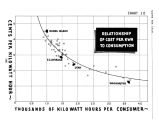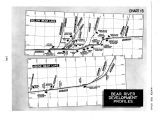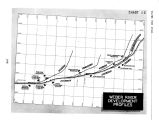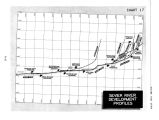| OCR Text |
Show WATER FOR UTAH which are largely poor in carbon and fuel. The State's salt, potash and phosphate resources are an urgent complement to the industrial pattern of the whole West. Its iron and steel production, which is at an early stage of development, is fundamental to the growth of a healthy and secure western economy. All of these industrial developments require enormous quantities of electric power and water. ( See Table 6 - Water and Power Requirements for the Production of Certain Important industrial materials - page 47.) Although their individual requirements can be listed in detail and to an impressive total, other unlisted industries, sometimes satelitic in nature, are likely to seek location in the State by virtue of its raw materials and other establishment factors. New technology - perhaps yet in the laboratory stage and which cannot be anticipated fully - must be given an advance place in the State's total power requirements. If would indeed be poor and short- sighted policy to restrict potential development of hydroelectric power sources in the State to such industries which can now be visioned as definitely potential of establishment. It must be remembered that new industries cannot wait for power supplies to be developed when all other factors are favorable. Thus new power capacity and transmission systems must be built well in advance of actual market definition; this principle is well recognized in other parts of the United States, particularly in the West. It seems therefore highly desirable to provide for the. potential power requirements in Utah for such industries as iron and steel and their manufacture; certain ferroalloys such as fer- rovanadium, ferrotungsten, ferromolybdenum; copper, lead and zinc and their mining, beneficia- tion, refining and fabrication; the entire supporting structure of the fertilizer industry, including potash and phosphatic fertilizers together with potash and phosphorus chemicals, synthetic ammonia; chlorine and caustic soda; calcium carbide and its acetylene derivative family; the entire range of products derived from coal and other hydrocarbons such as synthetic liquid fuels, coke, chars, tar and petroleum coke. In addition, the power requirements of other industries based on Utah's raw materials and expanding economic pattern must be anticipated. The State cannot afford to turn down industries in the future because of a paucity of electric . power of low cost - neither can the West nor the Nation. The total industrial load anticipated for 1970 is on the order of over 3 billion kilowatt- hours, or a fivefold increase in twenty years. This is conservative in view of the State's infant industrial pattern, which is susceptible to great expansion to meet national and western needs. ( See Chart 11 - Energy Requirements by Class Use - page 92.) ... Utah's Opportunity for Railroad Electrification ... There are other power requirements in the State such as for highway lighting, railroads and railways, which will also add to the generally upward trends of power consumption. It is estimated that the 1970 consumption in these classifications will reach at least 63 million kilowatt- hours. However, not included in these requirements are those for electrification of the major railroad systems traversing the State. Although present trends in the railway transportation industry of the United States is toward the greater use of Diesel- electric locomotives, the critical petroleum situation in the Nation may force consideration of other types of motive power. Higher prices and short supply of the petroleum distillates used for Diesel engines may well provide a compelling reason for a shift to the greater use of the straight electric locomotive. It has long been recognized that this type of motive power excels for the movement of traffic involving long mountain grades. Although the initial capital investment for railroad electrification is perhaps double that of complete Dieselization for the same trackage and traffic volume, its operation costs- given favorable electric power rates as against continuing rising oil prices - would be sufficiently less so as to pay for the difference in from 5 to 10 years. Therefore, the urgency of conservation of petroleum resources and the inherent advantages of railroad electrification should make possible the full electrification of Utah's railroads by 1970, provided power supplies at a reasonable price are readily available. The annual consumption for such electrification would be on the order of three hundred to four hundred million kilowatt hours per year. [ 931 |

















































































































































